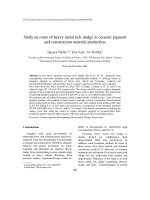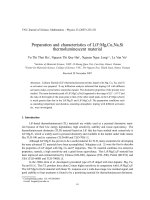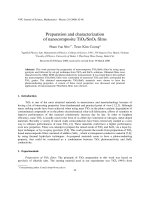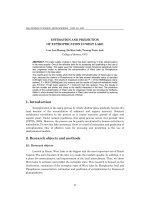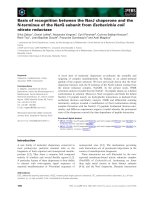Tài liệu Báo cáo "Preparation and characterization of nanocomposite TiO2/SnO2 films " pdf
Bạn đang xem bản rút gọn của tài liệu. Xem và tải ngay bản đầy đủ của tài liệu tại đây (346.52 KB, 5 trang )
VNU Journal of Science, Mathematics - Physics 24 (2008) 42-46
42
Preparation and characterization
of nanocomposite TiO
2
/SnO
2
films
Pham Van Nho
1,*
, Tran Kim Cuong
2
1
Applied Physics Lab, Department of Physics, College of Science, VNU, 334 Nguyen Trai, Hanoi, Vietnam
2
Faculty of Physics, University of Dalat, 1 Phu Dong Thien Vuong, Dalat City
Received 28 February 2008; received in revised form 19 March 2008
Abstract: This work presents the preparation of nanocomposite TiO
2
/SnO
2
films by using spray
pyrolysis and followed by sol-gel technique from TiCl
4
and SnCl
4
solutions. Obtained films were
characterized by XRD, SEM and photoconductivity measurement. It was found that in this method
the nanocomposite TiO
2
/SnO
2
films were constituted of nanosized TiO
2
and SnO
2
surrounded the
TiO
2
grains. The obtained nanocomposite TiO
2
/SnO
2
materials were shown to have the
photoconducting properties. A reason of these novel properties was discussed and practical
applications of nanocomposite TiO
2
/SnO
2
films were showed.
1. Introduction
TiO
2
is one of the most attracted materials in nanoscience and nanotechnology because of
having a lot of interesting properties from fundamental and practical point of view [1,2,3]. Although
many striking results have been achieved when using nano TiO
2
in the photo catalytic degradation of
contaminated compounds or in the photo electrochemical solar-cell fabrication, efforts of scientists to
improve performances of this material continuously increase day by day. In order to heighten
efficiency, nano TiO
2
is usually used in the form of as either dye sensitized or nitrogen, metal doped
materials. Recently a variety of mixed oxide semiconductors have been extensively studied as a new
way to enhance performances of nano TiO
2
[4]. These materials could have a higher performance,
even new properties. There was attempt to prepare the mixed oxide of TiO
2
and SnO
2
via a layer-by-
layer technique, or by co-spray pyrolysis [5,6]. This work presents the results from preparation of TiO
2
based nanocomposite films consisted of additive SnO
2
, which is transparent conductive material [7,8],
by using thermal hydrolysis techniques. As-prepared materials seem to have a photoconducting
property, that could be considered as a combination between TiO
2
photosensitivity and SnO
2
conductivity.
2. Experimentals
Preparation of TiO
2
films: The principle of TiO
2
preparation in this work was based on
pyrolysis of chloride salts. The starting material used in our experiments was TiCl
4
(99%) from
______
*
Corresponding author. E-mail:
P.V. Nho, T.K. Cuong / VNU Journal of Science, Mathematics - Physics 24 (2008) 42-46
43
MECRK. The salts were dissolved into distilled water to concentrations appropriate for spraying. The
obtained aqueous solutions were then subjected to a spraying process with the help of a glass atomizer,
operating with an air stream at 1.5 to 2 atm. The substrates were 1.2 mm-thick microscope glass slides.
Substrates were preheated to a given temperature, which was kept constant with the help of an
electronic digital controller. Under an open-air environment and at high temperature, hydrolysis of Ti
salt solutions takes place, resulting in the formation of TiO
2
deposited on the substrate. By varying the
temperatures, we found the optimal conditions for preparing TiO
2
with high performance. TiO
2
films
were formed on the glass substrates at temperatures in the range of 350-450
o
C. Such prepared films
had average thicknesses from 200 to 230 nm, measured by using Alpha step equipment.
Fig. 1. XRD from TiO
2
film prepared at 400
O
C.
Fig. 2. The SEM of TiO
2
prepared at 400
o
C.
d=1.696
d=1.660
d=1.48 2
d=1.892
d=2.346
d=3.509
20
40
60
80
100
120
160
180
140
20
30
40
50
60
70
d = 2.346
d = 1.892
d = 1.696
d = 1.696
d = 3.509
2 Theta-Scale
Lin (Cps)
P.V. Nho, T.K. Cuong / VNU Journal of Science, Mathematics - Physics 24 (2008) 42-46
44
After deposition, the obtained films were subjected to X-ray diffraction (XRD) and scanning
electron microscopy (SEM) analyses to identify the structure, and the morphology of the samples.
Figure 1 shows the XRD result for the TiO
2
film prepared from TiCl
4
at 400
o
C. The sharp peaks of the
XRD pattern indicate that TiO
2
with high crystallinity and high phase purity was formed from the
TiCl
4
solution by using thermal hydrolysis. The average size of crystalline TiO
2
calculated from the
XRD data is ca 9-15 nm. The morphology of film is shown in Fig. 2. The films prepared by using
spray pyrolysis were shown to have a porous structure. The evaporation of solvents and volatile
products, took place simultaneously with the deposition process, caused the porosity of the TiO
2
films.
Prepareation of TiO
2
/SnO
2
: After the material characterization had been determined, the
obtained nano crystalline TiO
2
were subjected to the coating with SnO
2
. Because of porous structure,
the TiO
2
films
were coated by using the sol-gel method. The films were impregnated in the sol
prepared from SnCl
4
. When the films had been dried, they were followed by annealing at high
temperature in order to form SnO
2
. For the best results, impregnations were carried out by varying
concentration of the SnCl
4
solution, and the films were annealed at different temperatures and for
different period of time.
Photoconductivity measurement
In order to evaluate properties of obtained films we have used the photoconductivity
measurement. The samples were prepared in a shape of photo resistor. Contact electrodes were made
from SnO
2
:F. The sheet resistance of the contacts is about 10 Ω/□. The connections of these contacts
with output terminals were realized by help of the silver paste. Contacting characteristics of the
systems SnO
2
:F/TiO
2
/SnO
2
:F was evaluated by the current-voltage measurement. The typical results
are shown in Fig. 3. As is seen from Fig. 3, the contacts between SnO
2
to investigated TiO
2
are shown
to be of the Ohmic, which required for photoconductivity measurement.
-8
-6
-4
-2
0
2
4
6
8
-20 -15 -10 -5 0 5 10 15 20
V (Volt)
I ( µ
µµ
µA )
Fig. 3. I-V characteristic of SnO
2
/TiO
2
:SnO
2
/SnO
2
system.
The dark resistance (R
D
) and the light resistance (R
L
) under the irradiation of 7W Hg lamp at
the distance of 10cm were measured. The calculated ratio of R
D
/R
L
was considered as a
photoconductivity of obtained materials. The results of measurements show that all values R
L,
R
D,
and
R
D
/R
L
strongly depend on the temperature and time of annealing as presented in Fig. 4.
P.V. Nho, T.K. Cuong / VNU Journal of Science, Mathematics - Physics 24 (2008) 42-46
45
0
100
200
300
400
500
600
0 5 10 15 20 25
Time (min)
R
D
/R
L
325°C
350°C
375°C
400°C
425°C
Fig. 4. The R
D
/R
L
dependences of TiO
2
films impregnated for 20 hours in the 0.8M SnCl
4
solution on the
temperatures and time of annealing.
Photoconductivity spectra of these photo resistors were also estimated. Fig. 5 shows this
characteristic, which was determined under visible irradiation of a Halogen lamp through the prism
monochromator
.
It can be seen that TiO
2
/SnO
2
photoresistors are sensitive only to ultraviolet rays.
1
1.5
2
2.5
300 400 500 600 700 800
Wavelength (nm)
R
D
/R
L
325°C
375°C
425°C
Fig. 5. R
D
/R
L
spectra of TiO
2
prepared at 400
o
C impregnated and annealed at 325, 375 and 425
o
C.
3. Discussion
TiO
2
belongs to dielectric materials. With a wide band gap of 3.2 eV, at room temperature there
are no free carriers in the conducting band. Under ultraviolet irradiation of a wavelength shorter than
the 380nm, TiO
2
can be excited, some photo electrons jumped to conducting band and can take part in
the electric conduction. However the systems of high energy band gap having a tendency to produce
high potential barrier on the grain boundary, impedes intergrain movement of excited carriers.
Therefore there was no photocurrent appeared despite the material was irradiated. SnO
2
is the high
conducting material. When deposited on the surface of TiO
2
grains they could decrease potential
P.V. Nho, T.K. Cuong / VNU Journal of Science, Mathematics - Physics 24 (2008) 42-46
46
barriers so excited carriers can be easily to move through, produced photocurrent in this system. In this
work, SnO
2
was formed from SnCl
4
during annealing impregnated TiO
2
film. Therefore photoeffect of
impregnated TiO
2
films increases according to time and temperature of annealing. In the other hand,
SnO
2
is self-doping semiconductor. Due to the stoichiometric deviation, some Sn atoms were formed
and played a role of the dopant. These dopant atoms at high temperature and for a long time annealing
experienced an oxidation, which resulted in the decrease of photo effect as shown in Fig. 4. The
existence of two conflicting processes is the reason of the maximal photo effect during the annealing
time.
4. Conclusions
The nanocomposite TiO
2
/SnO
2
films have been prepared via two steps of spray pyrolysis for
TiO
2
and sol-gel for SnO
2
. As prepared films exhibit a nanocomposite structure, constituting of a
majority of TiO
2
and a small amount of SnO
2
located on the TiO
2
grain surfaces, which decreased
potential barriers, made photocurrent appear in the system under irradiation of UV light.
This result suggests a manufacture of the highly efficient UV detector by using simple methods
and inexpensive materials.
Acknowledgements. This work was supported by the National Program on Fundamental Research of
Vietnam, Grant N 405606.
References
[1] N. Castillo, D. Olguin, A. Conde- Gallardo, S. Jiménez- Sandoval, Structural and morphological properties of TiO
2
thin
films prepared by spray pyrolysis, Revista Mexicana De Física 50 (4) (2004) 382.
[2] Dirk Verhulst, Bruce J. Sabacky, Timothy M. Spitler, Jan Prochazka, A new process for the production of nanosized
TiO
2
and other ceramic oxides by spray hydrolysis, www.altairnano.com/document/A2003-02-25verhulst.pdf
[3] Pham Van Nho, Hoang Ngoc Thanh, I. Davoli, Characterization of nanocrystalline TiO
2
films prepared by means of
solution spray method, Proceedings of the 9th APPC, Hanoi (2004) 348
[4] Wen-Deng Wang, Fu-Qiang Huang, Cun-Ming Liu, Xin-Ping Lin, Jian-Lin Shi, Preparation, electronic structure and
photocatalytic activity of the In
2
TiO
5
, Materials Science and Engineering: B Vol. 139 (1) (2007) 74.
[5] J.H. Kim, S.H. Kim, et al., Fabrication of nanoporous and hetero structure thin film via a layer-by-layer self assembly
method for a gas sensor, Sensors and Actuators B-Chemical 102 (2) (2004) 241.
[6] Pham Van Nho, Tran Kim Cuong, Enhanced UV detecting properties of nano TiO
2
, VNU Journal of Science,
Mathematics - Physics T. XXII, No 2AP (2006) 119.
[7] C. Terrier, J.P. Chatelon, R. Berjoan, J.A. Roger, Sb-doped SnO
2
transparent conducting oxide from the sol-gel dip-
coating technique, Thin solid Films 263 (1995) 37.
[8] J P Chatelon, C Terrier, J A Roger, Electrical and optical property enhancement in multilayered sol-gel-deposited SnO
2
films, Semicon. Sci. Technol., 14 (1999) 642.
